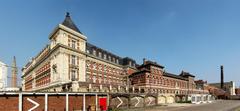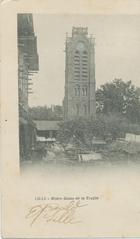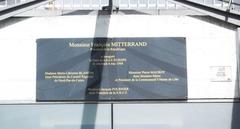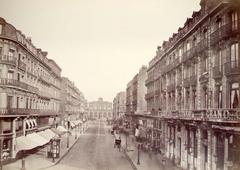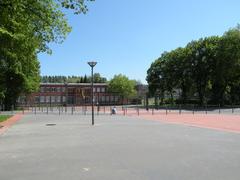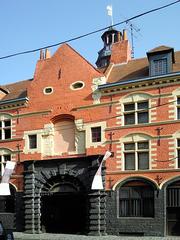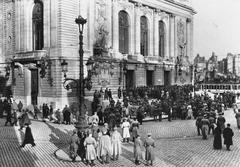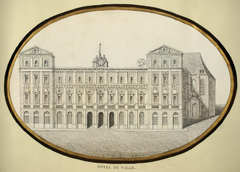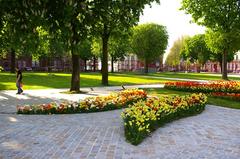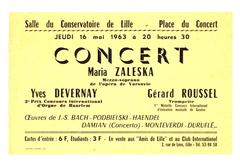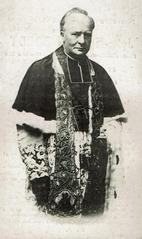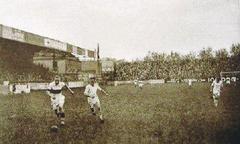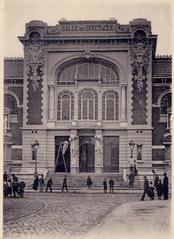Port De Lille Visiting Hours, Tickets, and Historical Sites: The Complete Guide
Date: 04/07/2025
Introduction to Port De Lille
Port De Lille, nestled along the Deûle River in the vibrant French city of Lille, stands as a testament to the region’s layered industrial heritage and its ongoing urban transformation. Originating in the Middle Ages as a key trading post between France and Flanders, the port has evolved into France’s third-largest inland logistics hub and a dynamic leisure destination. Whether you are drawn by industrial history, sustainable urban initiatives, or scenic riverside strolls, Port De Lille offers a multifaceted visitor experience. This guide provides everything you need: practical information on visiting hours and tickets, historical context, nearby attractions, and expert tips for making the most of your time at the port.
For official updates, refer to the Ports de Lille official website and the Lille Tourism Board.
Table of Contents
- Introduction
- Historical Evolution and Significance
- Economic and Logistical Importance
- Sustainability and Urban Development
- Access and Transport
- Visiting Hours, Tickets, and Tours
- Activities and Nearby Attractions
- Visitor Tips and Frequently Asked Questions (FAQ)
- Future Prospects and Regional Impact
- Key Facts and Figures
- Summary and Practical Advice
- References
Historical Evolution and Significance
Port De Lille’s history traces back to the medieval era, with its earliest port facilities established along the Basse Deûle in 1245 and the Haute-Deûle (quai du Wault) documented by 1370. These early river ports facilitated Lille’s emergence as a major trade center linking France to Flanders and beyond (fr.wikipedia.org; Nomads Travel Guide). Industrialization in the 19th century saw the port area shift and expand, notably with the construction of Port Vauban (circa 1870) and its integration with the railway network by 1877.
The modern Port De Lille was formally established by decree on April 20, 1935, reflecting the city’s adaptation to new transportation technologies and urban planning (fr.wikipedia.org). While the old port sites faded, Port De Lille solidified its role as a logistical heart of northern France, linking river, rail, and road networks.
Economic and Logistical Importance
Today, Port De Lille operates as the third-largest inland port in France, surpassed only by Paris and Strasbourg (fr.wikipedia.org). Its network includes 12 multimodal inland ports and container terminals, spanning over 237 hectares, and handles nearly 8 million tonnes of cargo annually (portsdelille.com). The port supports:
- Four Major Container Terminals: Located at Lille, Santes, Halluin, and Béthune, strategically placed near key transport corridors.
- Multimodal Connectivity: Integration of waterway, rail, and road allows for efficient transshipment and broad European reach, including access to Dunkirk, Calais, and Antwerp (interregnorthsea.eu).
- Urban Distribution: The Centre Multimodal de Distribution Urbaine (CMDU), launched in 2015, supports sustainable delivery with clean vehicles and circular economy logistics.
Port De Lille’s operational efficiency is notable, with rapid truck handling (average dwell time of 15 minutes) and the capacity to support XXL and heavy cargo (portsdelille.com).
Sustainability and Urban Development
Port De Lille has become a model for sustainable urban logistics. Managed by Voies Navigables de France, the port authority collaborates with public and private partners to implement eco-friendly freight solutions and reduce urban congestion (interregnorthsea.eu). The CMDU, operated by Veolia and partners, provides shared storage and reverse logistics for local businesses, minimizing emissions in Lille’s core.
Strategic enhancements, including the Seine-Scheldt Project (due for completion in 2030), will expand the port’s navigability and economic integration, unlocking new opportunities for business, tourism, and environmental stewardship (interregnorthsea.eu).
Access and Transport
By Public Transport
Port De Lille is easily reached via Lille’s comprehensive public transport system. The dedicated Port de Lille metro station (Line 2) connects the port area to the city center and both major train stations—Lille-Flandres and Lille-Europe. Both stations are well-served by TGV, Eurostar, and Thalys lines, linking Lille to Paris, Brussels, and London (becoming-carmen.com; Lille Tourism).
By Car
The port is accessible from major highways (A1, A22, A25, A27), with parking available near the quays. For stress-free travel, consider using Lille’s park-and-ride facilities in conjunction with public transport (britannica.com).
By Bicycle
Lille is a bike-friendly city, with dedicated cycling paths and the V’Lille bike-sharing system. Scenic riverside routes connect the port to the Citadel Park, Bois de Boulogne, and surrounding neighborhoods (komoot.com).
Visiting Hours, Tickets, and Tours
General Access
- Public Access: The port’s pedestrian quays and adjacent parks are open year-round, 24/7, making them ideal for walking, cycling, and riverside relaxation.
- Guided Tours: Access to operational logistics zones is restricted, but guided tours are available during special events (e.g., European Heritage Days in September). Advance booking is essential and can be done via the Ports de Lille website or the Lille Tourism Board.
Activities and Ticketing
- River Cruises: Scheduled river cruises operate from April to October, generally between 10:00 AM and 6:00 PM. Tickets can be purchased online or at the port kiosks. Advance booking is recommended, especially during weekends or festivals (Nomads Travel Guide).
- Industrial Heritage Tours: Bookable through local museums or the tourism office, these tours offer access to restored warehouses and historical displays, typically priced at €10–€20 (TravelSetu).
- Boat Rentals: Electric boats and pedalos are available seasonally, starting at around €15 per hour (cktravels.com).
- Parc de la Citadelle and Zoo de Lille: Both are free to enter and located adjacent to the port (The Tourist Checklist).
Activities and Nearby Attractions
Riverside Walks and Cycling
Stroll or cycle along the Deûle River, with paths connecting to Parc de la Citadelle, Bois de Boulogne, and beyond. Bicycle rentals are widely available (komoot.com).
River Cruises and Industrial Heritage
Take a river cruise for unique perspectives on Lille’s architecture and waterways. Join industrial heritage tours to explore the port’s transformation and see historical cranes, warehouses, and interpretive displays (TravelSetu).
Dining and Leisure
Enjoy Flemish cuisine at riverside cafés and estaminets. Local specialties include carbonnade flamande and regional beers, often served on outdoor terraces (Dreaming in French Blog).
Events and Festivals
The port hosts cultural and sporting events, including the famed Braderie de Lille every September—Europe’s largest flea market. Expect markets, food stalls, and live performances along the waterfront (France Voyage).
Nearby Points of Interest
- Vieux-Lille (Old Town): A short walk from the port, featuring cobbled streets and Flemish architecture (The Tourist Checklist).
- Grand Place: The city’s central square, lined with historic buildings and bustling cafés.
- Palais des Beaux-Arts: One of France’s premier art museums (Lonely Planet).
Visitor Tips and Frequently Asked Questions (FAQ)
Tips
- Best Visiting Months: April–October for pleasant weather and active events (Best Time To Visit Lille).
- Accessibility: The port and adjacent parks are wheelchair- and stroller-friendly, with paved paths and ramps.
- Sustainable Travel: Use public transport or cycling to align with the city’s eco-friendly ethos.
- Photography: The port is highly photogenic, especially at golden hour. Always ask before photographing people in cafés or events.
FAQs
Q: Is Port De Lille open year-round?
A: Yes, the public quays and parks are accessible 24/7. Specific tours or activities have set hours and may be seasonal.
Q: Are there entrance fees?
A: Entry to the port and adjacent parks is free. Fees apply only for guided tours, boat rentals, or river cruises.
Q: How do I get there from central Lille?
A: By metro (Line 2, Port de Lille station), bus, bicycle, or car. The area is well-connected and signposted (lilletourism.com).
Q: Is the port suitable for families?
A: Absolutely; the adjacent Parc de la Citadelle, free zoo, and riverside picnic spots are popular with families.
Q: What are the options for boat tours?
A: Seasonal sightseeing cruises, themed gastronomic tours, and private charters. Tickets are available online or at the port.
Q: Are events held at the port?
A: Yes, especially during major festivals (e.g., European Heritage Days, Braderie de Lille).
Future Prospects and Regional Impact
Port De Lille’s modernization continues, notably with the Seine-Scheldt Project, which will enhance waterway capacity and European connectivity by 2030 (interregnorthsea.eu). These developments are expected to boost regional economic growth, tourism, and environmental quality, positioning the port as an exemplar for sustainable urban logistics in France.
Key Facts and Figures
- Established: 1935 (modern port)
- Area: 237+ hectares across 9 sites
- Annual Cargo Throughput: ~8 million tonnes (2017)
- Container Traffic: Over 110,000 TEU (2015)
- Waterway Network: 680+ km (241 km suitable for large vessels)
- Multimodal Terminals: 4 major container terminals
- Metro Access: Port de Lille station (Line 2)
- Sustainability Initiatives: CMDU, clean vehicles, circular economy logistics
Summary and Practical Advice
References
- Port de Lille, 2023, Wikipedia
- Ports de Lille Official Website, 2023
- Interreg North Sea Region, Ports of Lille Pilot, 2023
- Nomads Travel Guide, Lille City Overview, 2023
- TravelSetu, Lille Tourism History, 2023
- Best Time To Visit Lille, 2023
- The Tourist Checklist, Things to Do in Lille, 2023
- France Voyage, Lille Events, 2023
- Dreaming in French Blog, Things to Do in Lille, 2023
- Lonely Planet, Weekend in Lille, 2023
- Becoming Carmen, Lille Travel Guide, 2023
- Britannica, Lille Overview, 2023
- Komoot, Attractions Around Lille, 2023
- CK Travels, Things to Do in Lille, 2023
- Travelfrancebucketlist, Day Trips from Lille, 2023
- French Moments, Around Lille, 2023
